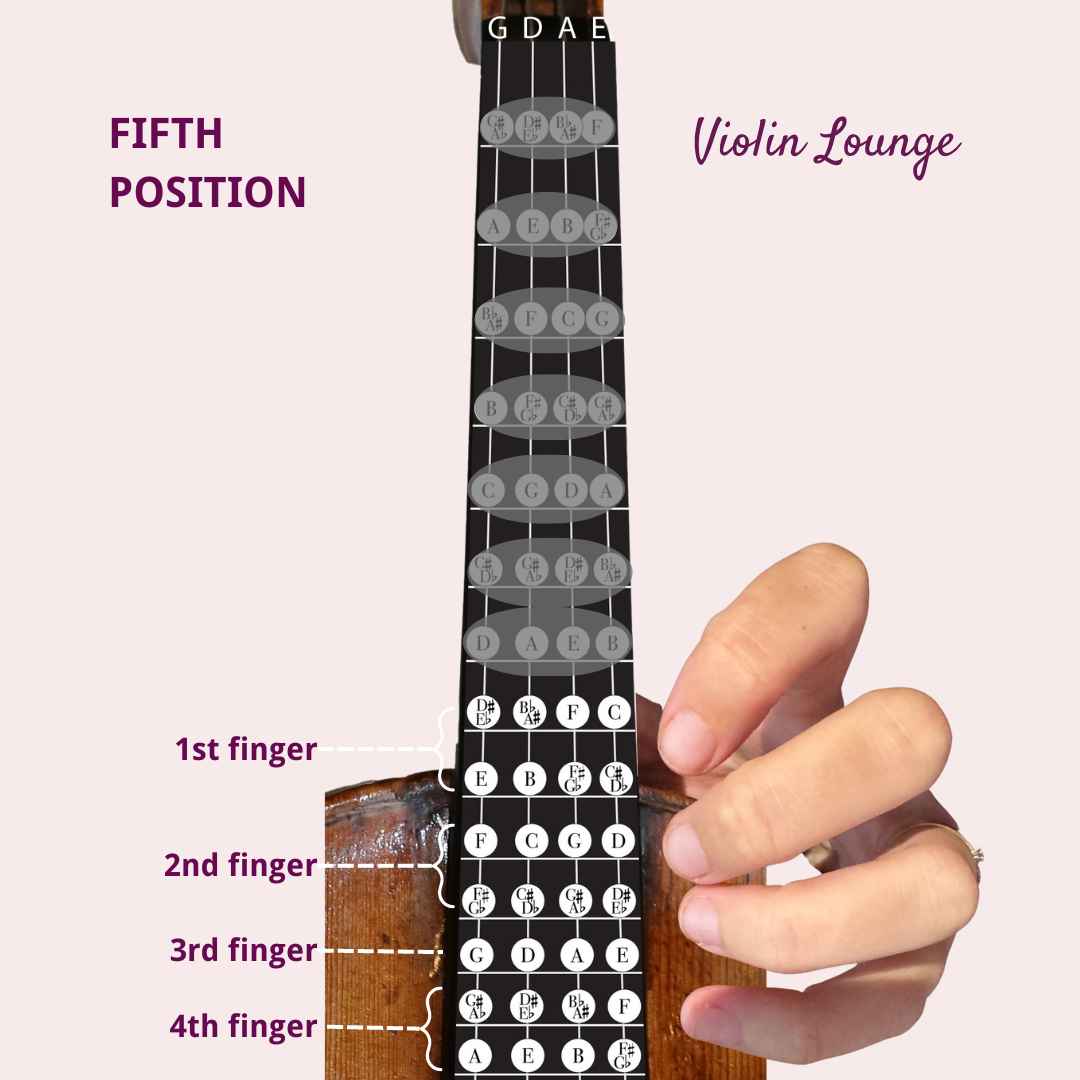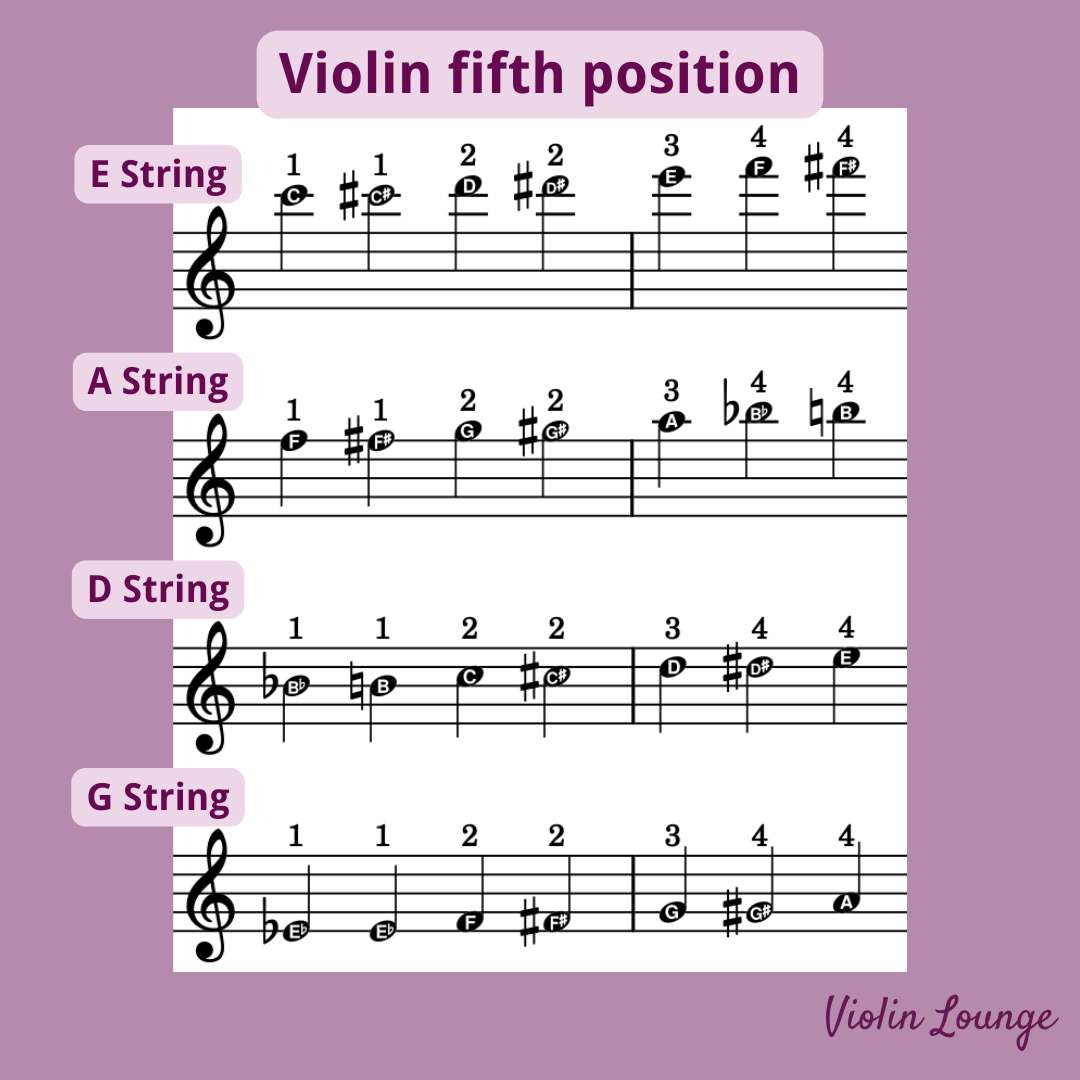Violin Fifth Position – all notes, finger chart and exercises
Finding Fifth Position
Tricks to find the fifth position on the violin
Fifth position is one of the easier ones to find, despite being so high. Here’s one trick you can use: in fifth position your wrist will be up against the edge of your violin. In all the lower positions, first finger and your left thumb can be across from each other. Starting from fifth position, however, the thumb stays touching the heel of the violin while first finger moves forward to bring the hand up around the instrument.
Here’s another trick if you’re playing “regular” fifth position (E on G string, B on D string, F# on A string, or C# on E string): first finger will be directly over the “purfling”, or decorative black edge, of your violin.
If you have already learned third position, it is easy to fifth from there: just shift first finger to where your third finger is in third position.
Finger Chart of Fifth Position
As we alluded to above, fifth position can start in slightly different places depending what key you are in. Here we show the full possibilities:

Notes in Fifth Position
The full chromatic range of notes you can play in fifth position is as follows, starting from “low” fifth position:
G string: D#/E♭, E, F, F#/G♭, G, G#/A♭, A
D string: A#/B♭, B, C, C#/D♭, D, D#/E♭, E
A string: F, F#/G♭, G, G#/A♭, A, A#/B♭, B
E string: C, C#/D♭, D, D#/E♭, E, F, F#/G♭
Sheet music of the fifth position
This is what the fifth position notes look like in violin sheet music. I’ve chosen between notes that are enharmonically the same. Of course if a F# is possible, a Gb is possible too (also see the finger chart above).

Example of Fifth Position
Meditation de Thais by Jules Massenet is a wonderful violin solo for exploring fifth position. It’s short, beautiful, and just challenging enough for someone at this stage without being overwhelming. It will really help you learn the fifth position notes on each string. Watch this video of Augustin Hadelich playing it, and see if you can catch the fifth position passages. Then watch the score video to see where fifth position is marked.
Fifth Position in Sheet Music
Aside from third, fifth position is the most common higher position. Being able to play in third and fifth will greatly widen your horizons. Here’s some great examples of fifth position etudes to help you learn this skill:
- Introducing the Positions, Vol. 1 by Harvey S. Whistler
- 36 Violin Studies, Op. 20 by Kayser (the last twelve include fifth position)
- Concerto in A Minor by Accolay
- Adoration by Felix Borowski
- Meditation de Thais by Massenet
How to Learn Fifth Position
To learn fifth position, remember the same tips we learned in the third position article. It is especially important to have a loose left thumb since your other fingers will have to move forward independently of the thumb. Also remember that finger spacing is slightly closer together the higher up the instrument you go.
Shifting straight from first to fifth position is a big jump. I recommend dividing the labor while learning where the position is for the sake of smoothness and stability. For example, you can practice playing a whole A Major scale on the A string just by shifting. As you go up the scale, shift to third position on the D and fifth position on the F#. You can do this to practice shifting on every string.
As you get more comfortable, do sliding shifts: starting with first finger in first position, gently slide up to fifth position, as you should always leave your gide finger on the string during a shift. Do it with the bow so you can hear the slide and know when you get to the top. Do it slowly at an even speed to learn the feel of shifting.
But how do you hide such a big slide later? The trick is to move the finger smoothly but quickly, barely touching the string, in between bow strokes or while moving the bow very slowly so no sound is heard. However, depending on the piece you may want a somewhat audible slide, which is often stylistic.

0 Comments